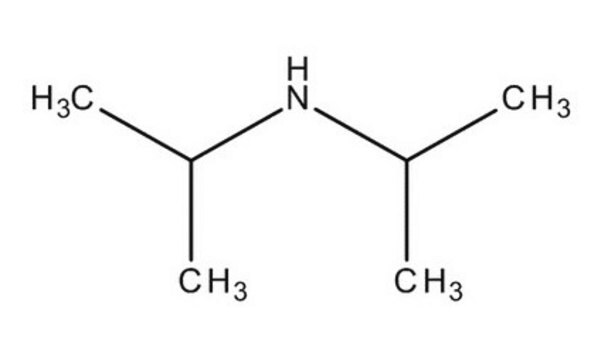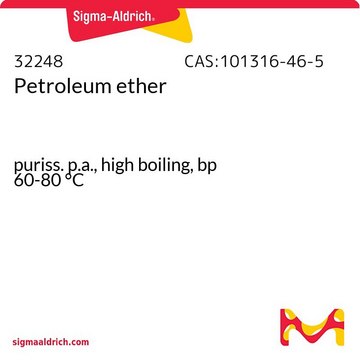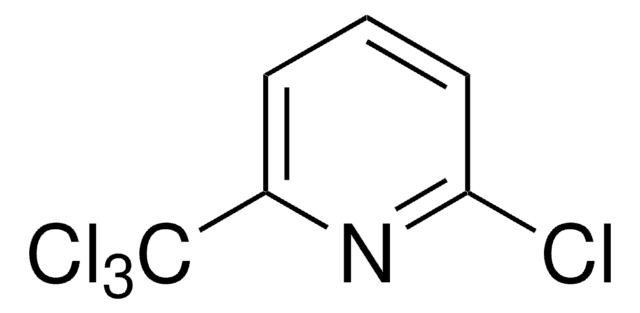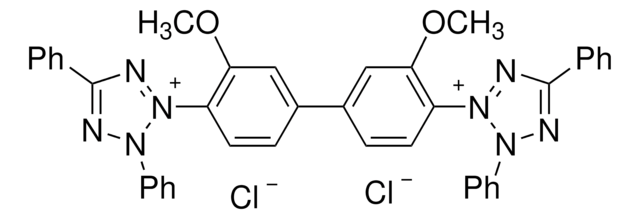38290
Diisopropylamine
puriss. p.a., ≥99.0% (GC)
Synonym(s):
DIPA
About This Item
Recommended Products
vapor density
3.5 (vs air)
Quality Level
vapor pressure
50 mmHg ( 20 °C)
grade
puriss. p.a.
Assay
≥99.0% (GC)
form
liquid
autoignition temp.
599 °F
expl. lim.
8.5 %
impurities
≤0.5% water
evapn. residue
≤0.001%
refractive index
n20/D 1.392 (lit.)
n20/D 1.393
bp
84 °C (lit.)
mp
−61 °C (lit.)
solubility
H2O: soluble 110 g/L at 25 °C (completely)
density
0.722 g/mL at 25 °C (lit.)
cation traces
Al: ≤0.5 mg/kg
Ba: ≤0.1 mg/kg
Bi: ≤0.1 mg/kg
Ca: ≤0.5 mg/kg
Cd: ≤0.05 mg/kg
Co: ≤0.02 mg/kg
Cr: ≤0.02 mg/kg
Cu: ≤0.02 mg/kg
Fe: ≤0.5 mg/kg
K: ≤0.5 mg/kg
Li: ≤0.1 mg/kg
Mg: ≤0.1 mg/kg
Mn: ≤0.02 mg/kg
Mo: ≤0.1 mg/kg
Na: ≤0.5 mg/kg
Ni: ≤0.02 mg/kg
Pb: ≤0.1 mg/kg
Sr: ≤0.1 mg/kg
Zn: ≤0.1 mg/kg
SMILES string
CC(C)NC(C)C
InChI
1S/C6H15N/c1-5(2)7-6(3)4/h5-7H,1-4H3
InChI key
UAOMVDZJSHZZME-UHFFFAOYSA-N
Looking for similar products? Visit Product Comparison Guide
Related Categories
Application
- Solvent extraction in environmental technology: Diisopropylamine was utilized in temperature swing solvent extraction for the zero liquid discharge of ultrahigh-salinity brines, demonstrating its utility in environmental cleanup and water treatment processes (Boo et al., 2020).
Signal Word
Danger
Hazard Statements
Precautionary Statements
Hazard Classifications
Acute Tox. 3 Inhalation - Acute Tox. 4 Oral - Aquatic Chronic 3 - Eye Dam. 1 - Flam. Liq. 2 - Skin Corr. 1B - STOT SE 3
Target Organs
Respiratory system
Storage Class Code
3 - Flammable liquids
WGK
WGK 2
Flash Point(F)
7.8 °F - closed cup
Flash Point(C)
-13.45 °C - closed cup
Personal Protective Equipment
Regulatory Listings
Regulatory Listings are mainly provided for chemical products. Only limited information can be provided here for non-chemical products. No entry means none of the components are listed. It is the user’s obligation to ensure the safe and legal use of the product.
FSL
Group 4: Flammable liquids
Type 1 petroleums
Hazardous rank II
Water insoluble liquid
ISHL Indicated Name
Substances Subject to be Indicated Names
ISHL Notified Names
Substances Subject to be Notified Names
JAN Code
38290-VAR-F:
38290-1L-F:4548173368689
38290-6X250ML-F:
38290-BULK-F:
38290-RSAMPLE:
38290-250ML-F:4548173368696
38290-6X1L-F:
38290-50ML-F:
Choose from one of the most recent versions:
Already Own This Product?
Find documentation for the products that you have recently purchased in the Document Library.
Customers Also Viewed
Our team of scientists has experience in all areas of research including Life Science, Material Science, Chemical Synthesis, Chromatography, Analytical and many others.
Contact Technical Service












